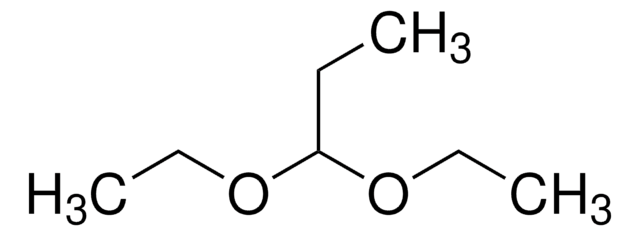538124
Propionaldehyde
reagent grade, 97%
Synonym(s):
Propanal
About This Item
Recommended Products
grade
reagent grade
Quality Level
vapor density
2 (vs air)
vapor pressure
18.77 psi ( 55 °C)
4.89 psi ( 20 °C)
Assay
97%
form
liquid
autoignition temp.
404 °F
expl. lim.
17 %, 26 °F
2.6 %, 31 °F
impurities
≤2.5% (water)
refractive index
n20/D 1.362 (lit.)
bp
46-50 °C (lit.)
mp
−81 °C (lit.)
solubility
organic solvents: soluble
density
0.805 g/mL at 25 °C (lit.)
storage temp.
2-8°C
SMILES string
[H]C(=O)CC
InChI
1S/C3H6O/c1-2-3-4/h3H,2H2,1H3
InChI key
NBBJYMSMWIIQGU-UHFFFAOYSA-N
Looking for similar products? Visit Product Comparison Guide
General description
Application
- Unraveling the electrocatalytic reduction mechanism of enols on copper in aqueous media.: Research on the electrocatalytic reduction mechanisms of enols, including implications for propionaldehyde, provides valuable information for chemical synthesis and industrial applications in catalysis (Cui et al., 2022).
Signal Word
Danger
Hazard Statements
Precautionary Statements
Hazard Classifications
Acute Tox. 4 Inhalation - Acute Tox. 4 Oral - Eye Dam. 1 - Flam. Liq. 2 - Skin Irrit. 2 - STOT SE 3
Target Organs
Respiratory system
Storage Class Code
3 - Flammable liquids
WGK
WGK 1
Flash Point(F)
-22.0 °F - closed cup
Flash Point(C)
-30 °C - closed cup
Certificates of Analysis (COA)
Search for Certificates of Analysis (COA) by entering the products Lot/Batch Number. Lot and Batch Numbers can be found on a product’s label following the words ‘Lot’ or ‘Batch’.
Already Own This Product?
Find documentation for the products that you have recently purchased in the Document Library.
Customers Also Viewed
Protocols
-Tolualdehyde; Valeraldehyde; Isovaleraldehyde
Our team of scientists has experience in all areas of research including Life Science, Material Science, Chemical Synthesis, Chromatography, Analytical and many others.
Contact Technical Service












